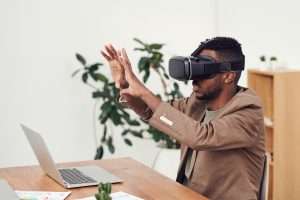Virtual reality. It’s one of those terms that we’ve all heard throughout our lives. In both fiction and real-world application, virtual reality seems to get tossed around somewhat casually. It may shock you to think that VR recruiting and VR training could thrive and impact the global job market.
Countless sci-fi novels have warned us about the dangers of virtual reality, artificial intelligence, and exciting types of possibilities obtained through advanced technology. But, what are some real-world applications for virtual reality? In the COVID and post-COVID era, could virtual reality impact the hiring process?
In this article, we’re going to look at what current VR technology exists and how it may impact the world of recruiting in the not-too-distant future.
The Basics of Virtual Reality
Before we discuss how your next job may have you VR training, let’s go over the fundamentals of virtual reality and how it’s understood today.
The Virtual Reality Society defines virtual reality as: the term used to describe a three-dimensional, computer-generated environment which can be explored and interacted with by a person. That person becomes part of this virtual world or is immersed within this environment and whilst there, is able to manipulate objects or perform a series of actions.
Sounds pretty remarkable doesn’t? The concept of virtual reality has fascinated storytellers, scientists, and entrepreneurs alike for decades. Until recently, virtual reality was not practical for daily use, which prohibited wide-spread adoption.
VR units and applications were cumbersome and nearly unaffordable for consumer use. A VR headset was an expensive parlor trick in the 1990s. Nothing exemplified this more than the failed 1995 VR video game console from Nintendo, the virtual boy.
But today, that has changed. Large electronic and software companies are producing affordable and, more importantly, desirable VR headsets. Sony Interactive Interactive Entertainment has the PlayStation VR, HTC has the VIVE, and just announced recently is highly-anticipated Oculus Quest 2. Oculus is owned by Facebook.
As far as the international conglomerates are concerned, there’s a bright future for virtual reality.
Is VR Here For Good This Time?
The sales figures and data are looking good for the virtual reality market. It’s estimated that by the end of 2020, sales of augmented reality (AR) and virtual reality headsets will reach about 5.5 million units. Also, it is forecasted that the market sees tremendous growth in AR/VR headset sales in the near future. By 2023, it is expected that over 26 million units will be sold each year.
The AR/VR market revenue forecasts predict a market evaluation of around 19 billion dollars by the end of 2020. This has tech companies excited, and between Microsoft, Sony, Google, and Intel, thousands of VR patents have been acquired.
Does Your Business Need To Draw Job Candidates From A Larger Talent Pool?
Learn How To Hire With Google And Increase Your Online Job Posting Visibility.
How Is VR Training Being Used?
While e-learning and video-based webinars are helpful for employees in training, they are “passive” mediums. This means that the employee in training is not actively engaged during the educational presentation. By learning through an interactive experience rather than passively retaining information relayed to them, employees can get more value from this type of immersive training.
Strivr is one of the fastest emerging VR-based immersive learning providers. They have conducted case studies for VR training across a range of skill categories.
These include soft skills training, customer service training, and operational efficiency training. The results collected suggest that employees are getting value and knowledge out of VR training sessions in less time.
A widespread adopter of Strivr’s training systems is Walmart. Walmart has trained over one million of its employees with VR. One of Walmart’s most popular training modules is something called “The Pickup Tower.” This simulation represents a standard nationwide procedure for Walmart staffers.
Walmart trainees experience what it’s like to operate a large kiosk that arranges customers’ online orders for pick up. Traditionally, training for this machine/operation needed to be done at specific locations and would take 8 hours to complete. The VR training sessions for The Pickup Tower have cut the training time down to 15 minutes.
Not Only Does The Ultimate Guide To Google For Jobs Exist,
But It’s Also Free On Our Website.
VR For Recruitment Purposes
During the post-pandemic era, hiring managers and recruitment teams need to be much more tactful and strategic about face-to-face interviews and screenings. Just as VR is seeing real-world applications with VR Training, VR Recruiting practices could see a bump in adoption as more recruiting departments become aware of its capabilities.
Virti, a tech-startup has created a cloud-based VR platform that looks to help to recruit efforts in the post-pandemic era. Virti’s platform allows applicants to take skills assessment tests and also experience virtual company tours. Even after the pandemic has subsided, this could have a practical use for recruiting employees in distant regions.
Actiview is another company looking to empower HR departments through virtual reality recruitment tools and AI-powered systems. As job candidates take a virtual reality assessment test, the systems record their data and determine how a candidate is performing based on their behaviors and performance during the test.
“Our technology is grounded in the integration between the worlds of neurological science, data science, and behavioral science..we can change the world of evaluations from end to end and let conceptual information analyze pure behavior, which provides a reliable forecast about the suitability of an applicant to the organization taking them in.” – Matanel Libi, Actiview CEO
Even as early as 2015, companies were looking to use VR to help create new and exciting recruitment tactics to attract talent. General Mills created a virtual tour of their world headquarters and previewed it at career fairs with the original Oculus Rift, and it drew positive attention from young jobseekers
Attracting Talent Through VR Training and Recruitment
Whether a business is thinking about VR for recruitment purposes or training purposes, it’s an exciting new platform with potentially endless applications.
Will jobs in the future be advertised with VR training or VR onboarding in the description? It’s quite possible, the technology is new and exciting for both jobseekers and employers. VR experiences that give employees more confidence, and save businesses time and money are hard to pass up.
Google has publicly shown interest in the potential of the VR industry. Integrating Google for Jobs job hosting/posting platform with VR technology could be a very advantageous step for Google.
Before you can enlist candidates to experience your corporate campus or train with your VR module, your online job posts must be visible. Learning how to post on Google for Jobs is the first step towards gaining visibility for the right candidates and increasing the talent pool to choose from.
To learn more about Google for Jobs, technologies, and recruitment trends here to stay, please contact us.





